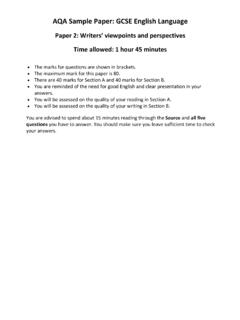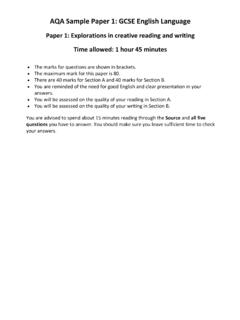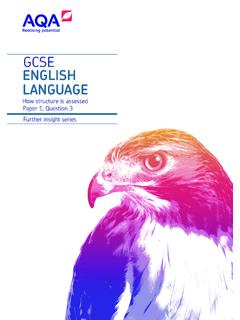Transcription of GCSE English Language Mock Paper 2 Specimen Mark …
1 MOCK Paper gcse English Language Paper 2 Writers viewpoints and perspectives Mark Scheme 8700 Version 2 MARK SCHEME KS3 English Language Paper 2 INTRODUCTION The information provided for each question is intended to be a guide to the kind of answers anticipated and is neither exhaustive nor prescriptive. All appropriate responses should be given credit. Where literary or linguistic terms appear in the Mark Scheme, they do so generally for the sake of brevity. Knowledge of such terms, other than those given in the specification, is not required. However, when determining the level of response for a particular answer, teachers should take into account any instances where the student uses these terms effectively to aid the clarity and precision of the argument. Level of response marking instructions Level of response mark schemes are broken down into four levels.
2 There are two, four, five or six marks in each level; dependent upon question. Please note: The sample responses in each Indicative Standard column are not intended to be complete, full or model answers. Instead, they are there as a guide, to provide you with part of an answer, an indicative extract of a response at the required level. If a student was to continue to develop a response at that standard, they would gain a mark at that level. Step 1 Determine a level Start at the lowest level of the mark scheme and use it as a ladder to see whether the answer meets the descriptor for that level. The descriptor for the level indicates the different qualities that might be seen in the student s answer for that level. If it meets the lowest level then go to the next one and decide if it meets this level, and so on, until you have a match between the level descriptor and the answer.
3 With practice and familiarity you will find that for better answers you will be able to quickly skip through the lower levels of the mark scheme. Step 2 Determine a mark Once you have assigned a level you need to decide on the mark. You may well need to read back through the answer as you apply the mark scheme to clarify points and assure yourself that the level and the mark are appropriate. The Skills Descriptors column indicates the different skills that students need to demonstrate in their answer for that level. To achieve full marks in a level, students should meet all of the skills descriptors in that level. Students achieving marks at the bottom of a level will ideally have met all of the skills descriptors of the previous level and at least one of the skills descriptors in that level.
4 An answer which contains nothing of relevance to the question must be awarded no marks . Copyright 2016 AQA and its licensors. All rights reserved. AQA retains the copyright on all its publications. However, registered schools/colleges for AQA are permitted to copy material from this booklet for their own internal use, with the following important exception: AQA cannot give permission to schools/colleges to photocopy any material that is acknowledged to a third party even for internal use within the centre. 3 MARK SCHEME KS3 English Language Paper 2 SECTION A: READING Assessment Objectives AO1 Identify and interpret explicit and implicit information and ideas. Select and synthesise evidence from different texts. AO2 Explain, comment on and analyse how writers use Language and structure to achieve effects and influence readers, using relevant subject terminology to support their views.
5 AO3 Compare writers ideas and perspectives, as well as how these are conveyed, across two or more texts. AO4 Evaluate texts critically and support this with appropriate textual references. SECTION B: WRITING Assessment Objectives AO5 Communicate clearly, effectively and imaginatively, selecting and adapting tone, style and register for different forms, purposes and audiences. Organise information and ideas, using structural and grammatical features to support coherence and cohesion of texts. AO6 Students must use a range of vocabulary and sentence structures for clarity, purpose and effect, with accurate spelling and punctuation. (This requirement must constitute 20% of the marks for each specification as a whole).
6 4 MARK SCHEME KS3 English Language Paper 2 Assessment Section A Objective AO1 AO2 AO3 AO4 n/a Section B AO5 AO6 5 MARK SCHEME gcse English Language Paper 2 Section A: Reading Read again Source A from lines 1 to 12. Choose four statements below which are TRUE. Shade the circles in the boxes of the ones that you think are true. Choose a maximum of four statements. If you make an error cross out the whole box. If you change your mind and require a statement that has been crossed out then draw a circle around the box. A Base camp is a cosy and happy place. B The temperature at base camp drops when the sun goes down. C Salkeld was so cold that she needed to put on more clothes. D The storm had hit Everest from the north.
7 E Salkeld was excited at the sight of the storm. F Salkeld had often seen storms like this on Everest. G They watched as the storm got closer to them. H The approaching storm looked like something from the end of the world. [4 marks ] AO1 Identify and interpret explicit and implicit information and ideas. Select and synthesise evidence from different texts. This assesses the first bullet point identify and interpret explicit and implicit information and ideas. A Base camp is a cosy and happy place. (F) B The temperature at base camp drops when the sun goes down. (T) C Salkeld was so cold that she needed to put on more clothes. (T) D The storm had hit Everest from the north. (F) E Salkeld was excited at the sight of the storm. (F) F Salkeld had often seen storms like this on Everest.
8 (F) G They watched as the storm got closer to them. (T) H The approaching storm looked like something from the end of the world. (T) 0 1 6 MARK SCHEME gcse English Language Paper 2 You need to refer to Source A and Source B for this question. The effects of the weather on people in both sources are very different. Use details from both sources to write a summary of the different ways people are affected by the weather. [8 marks ] AO1 Identify and interpret explicit and implicit information and ideas Select and synthesise evidence from different texts This assesses both bullet points. Level Skills Descriptors How to arrive at a mark Indicative Standard This indicative standard is not a model answer, nor a complete response. Nor does it seek to exemplify any particular content.
9 Rather it is an indication of the standard for the level. Level 4 Perceptive, summary 7-8 marks Shows perceptive synthesis and interpretation of both texts: Makes perceptive inferences from both texts Makes judicious references/use of textual detail relevant to the focus of the question Statements show perceptive differences between texts At the top of the level, a student s response will meet all of the skills descriptors. Source A conveys the horrific consequences of a sudden storm on Mount Everest when thirty climbers become trapped in the Death Zone and are left exposed and fighting for their lives . Three Indian climbers are stranded, exhausted and with their oxygen supplies running out , which suggests that they were caught unawares by the unexpected severity of the weather.
10 Maybe more significantly, two commercial expeditions were strung out between the South Col and the summit , showing the weather attacks both recreational climbers and business enterprises, who would consider the safety of their clients as 0 2 7 MARK SCHEME gcse English Language Paper 2 At the bottom of the level, a student will have Level 3 and at least one of the skills descriptors. important. This implies the effects are catastrophic for even the most prepared of people because there were eight fatalities: the greatest loss of life in any twenty-four hour period on the peak . This is different to Source B which focuses on a less traumatic event: a heavy snowfall in London in the 1800s. The people are cold and wrapped in thick coats but the effects are not life-threatening.











